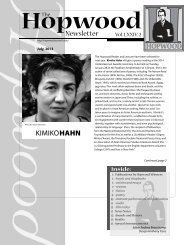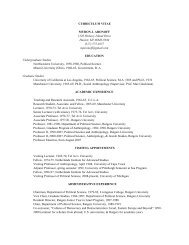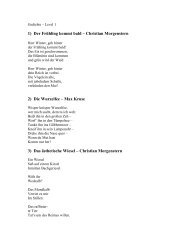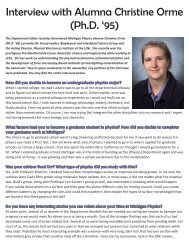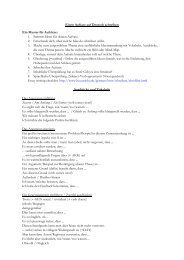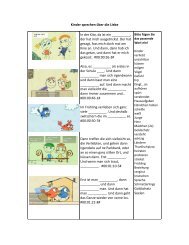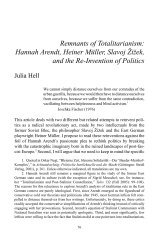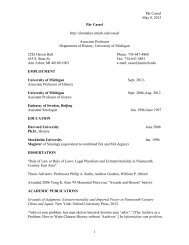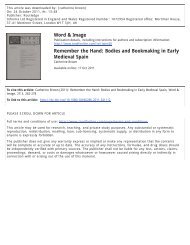ANNUAL REPORT - University of Michigan
ANNUAL REPORT - University of Michigan
ANNUAL REPORT - University of Michigan
You also want an ePaper? Increase the reach of your titles
YUMPU automatically turns print PDFs into web optimized ePapers that Google loves.
SUSTAINABILITY in ACTION<br />
Inspiration. Conservation. Education. Investigation. Participation. These are some <strong>of</strong> the<br />
reasons that people come to the Arb and Gardens. Our mission is to promote environmental<br />
enjoyment, stewardship and sustainability through education, research, and interaction with<br />
the natural world. Whether it is by using rain barrels, growing your own vegetables, converting<br />
your lawn to meadow or prairie, changing lawn care practices to more environmentally friendly<br />
ones, you can try these at home. Below are three personal accounts from visitors who learned<br />
what sustainability in action really means.<br />
Growing Food, Reserving Seeds<br />
ERIC KAMPE<br />
I had the pleasure <strong>of</strong> volunteering in the MBGNA<br />
greenhouses this past spring propagating<br />
heirloom vegetables for Project Grow Community<br />
Gardens and the annual Spring Plant Sale. We<br />
started basil, pepper, eggplant, and tomatoes<br />
from seed. We got our hands dirty and learned<br />
to prepare soil, sow seeds, transplant seedlings,<br />
water, and apply fertilizer. We also had fun<br />
chatting about gardening and speculating on how<br />
some <strong>of</strong> the more unusually named heirlooms<br />
would turn out.<br />
In the summer I was growing vegetables <strong>of</strong> all<br />
sorts for the “Gathering <strong>of</strong> Gardens” exhibit. There<br />
was plenty to do and learn: designing raised beds<br />
(<strong>of</strong>ten from reclaimed materials), preparing the<br />
soil, choosing vegetable varieties, and determining<br />
planting times. I learned which tomatoes I liked<br />
best fresh <strong>of</strong>f the vine, and which were better for<br />
my canned pasta sauce. I learned which varieties<br />
<strong>of</strong> squash, corn, beans, onions, and potatoes<br />
would store well and last beyond the summer<br />
season. I saved seed from lettuce, tomato, basil,<br />
bean, and squash completing the cycle and<br />
bringing my thoughts back to early spring when<br />
propagation will begin again.<br />
Having learned to propagate vegetables at<br />
Matthaei, I plan to continue doing it in my<br />
personal life. I will share the idea with everyone<br />
I know. It is so important to grow our own<br />
vegetables and I know that others can, too.<br />
I learned how to be a better steward <strong>of</strong> the earth<br />
at MBGNA – you can, too!<br />
Rain Barrels<br />
CARRIE B. RIEDEMAN<br />
I learned about rain barrels at<br />
the Spring Plant Sale last year<br />
when I saw the demonstration<br />
given by TJ Smith <strong>of</strong> the<br />
MBGNA staff. I purchased one<br />
right away. This is my second<br />
year with an MBGNA rain<br />
barrel, and I love it. Having<br />
it on our second-story deck<br />
(under a leaky gutter) makes<br />
watering my container plants<br />
a breeze – I don’t have to<br />
drag the hose halfway around<br />
the house! There’s very little<br />
maintenance required. I crush<br />
a mosquito dunk in through the<br />
mesh once or twice a summer,<br />
but since I’m drawing water<br />
out daily, stagnant water hasn’t<br />
been an issue.<br />
When it’s time to store the<br />
barrel for the winter, I fill as<br />
many plastic gallon jugs as I<br />
have and put them in a deck<br />
storage box to freeze. During<br />
the winter, I thaw them out as<br />
needed and use the water for<br />
my houseplants. The plants<br />
appreciate the rain water,<br />
rather than our treated well<br />
water, and I like the fact that<br />
my rain barrel is working for<br />
me all year long!<br />
Shrinking the Lawn<br />
MARJORIE BERNDT<br />
I have a beautiful red dogwood<br />
tree in my front yard and<br />
became concerned that there<br />
was too much competition for<br />
water and fertilizer from the<br />
lawn. In the past, I’ve spaded<br />
out the turf and hauled it away.<br />
But, as a woman <strong>of</strong> “a certain<br />
age,” I wanted something<br />
easier. So I asked some <strong>of</strong><br />
the MBGNA horticulturists for<br />
recommendations on how to<br />
easily transition from lawn to<br />
groundcovers. They suggested<br />
that I smother the grass with<br />
layers <strong>of</strong> newspaper; it would<br />
then decompose gradually and<br />
be incorporated into the soil.<br />
To hide the newspaper and to<br />
further conserve moisture, I<br />
covered it with bark mulch.<br />
It was simple to do and very<br />
effective. The grass is gone and<br />
now I’m ready to start planting<br />
some groundcovers in its place.<br />
I’ll pick some low maintenance<br />
varieties that I’ve seen at the<br />
Gardens through the years,<br />
Epimedium and Sedum to<br />
start. Soon I’ll have a beautiful,<br />
easy-care bed around my<br />
beloved dogwood.



